Zero-Dose, Under-Immunized, and Dropout Children in Nigeria: The Trend and Its Contributing Factors over Time
Abstract
1. Introduction
2. Methods
2.1. Data
2.2. Outcome Variables
2.3. Covariates
Analysis
2.4. Results
3. Discussion
4. Conclusions
Funding
Institutional Review Board Statement
Informed Consent Statement
Data Availability Statement
Conflicts of Interest
References
- Orenstein, W.A.; Ahmed, R. Simply put: Vaccination saves lives. Proc. Natl. Acad. Sci. USA 2017, 114, 4031–4033. [Google Scholar] [CrossRef] [PubMed]
- Sim, S.Y.; Watts, E.; Constenla, D.; Brenzel, L.; Patenaude, B.N. Patenaude. Return On Investment from Immunization Against 10 Pathogens in 94 Low-And Middle-Income Countries, 2011–30: Study estimates return on investment from immunization programs against ten pathogens for ninety-four low-and middle-income countries from 2011 to 2030. Health Aff. 2020, 39, 1343–1353. [Google Scholar]
- UNICEF. Immunization. 2022. Available online: https://data.unicef.org/topic/child-health/immunization/ (accessed on 11 November 2022).
- WHO/UNICEF. COVID-19 Pandemic Leads to Major Backsliding on Childhood Vaccinations, New WHO, UNICEF Data Shows. 2021. Available online: https://www.unicef.org/press-releases/covid-19-pandemic-leads-major-backsliding-childhood-vaccinations-new-who-unicef-data (accessed on 12 October 2022).
- ICF. The DHS Program STATcompiler. Funded by USAID. 2012. Available online: http://www.statcompiler.com (accessed on 12 October 2022).
- Save the Children. Scaling up Routine Immunization Coverage in Nigeria–Critical Month Ahead. 2022. Available online: https://www.savethechildren.org.uk/blogs/2022/scaling-up-routine-immunisation-coverage-in-nigeria (accessed on 12 October 2022).
- ICF. The DHS Program Website. Funded by USAID. Available online: http://www.dhsprogram.com (accessed on 12 October 2022).
- Jann, B. The Blinder–Oaxaca decomposition for linear regression models. Stata J. 2008, 8, 453–479. [Google Scholar] [CrossRef]
- Mahachi, K.; Kessels, J.; Boateng, K.; Achoribo, A.E.; Mitula, P.; Ekeman, E.; Lochlainn, L.N.; Rosewell, A.; Sodha, S.V.; Abela-Ridder, B.; et al. Zero-or missed-dose children in Nigeria: Contributing factors and interventions to overcome immunization service delivery challenges. Vaccine 2022, 40, 5433–5444. [Google Scholar] [CrossRef] [PubMed]
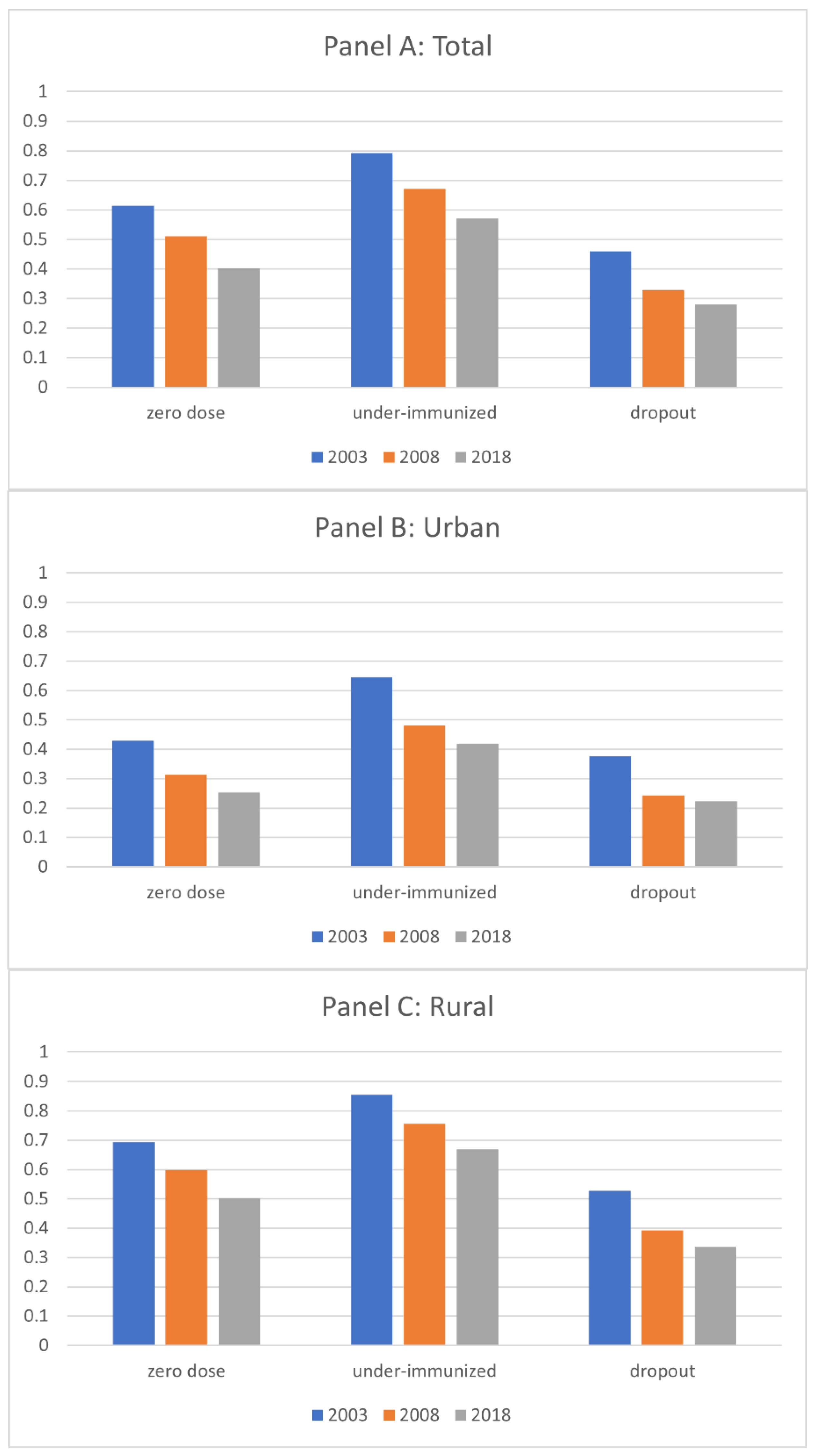
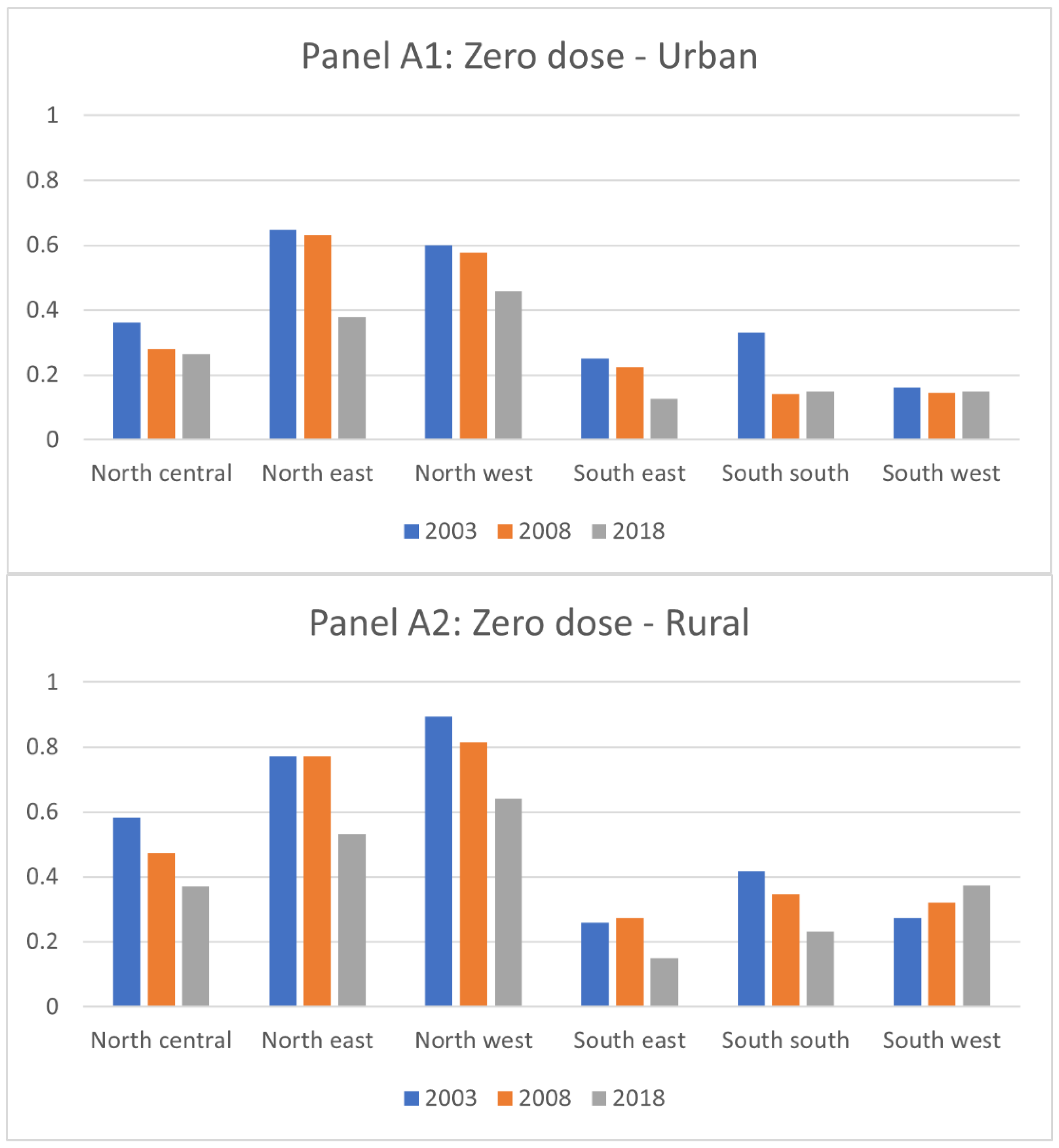
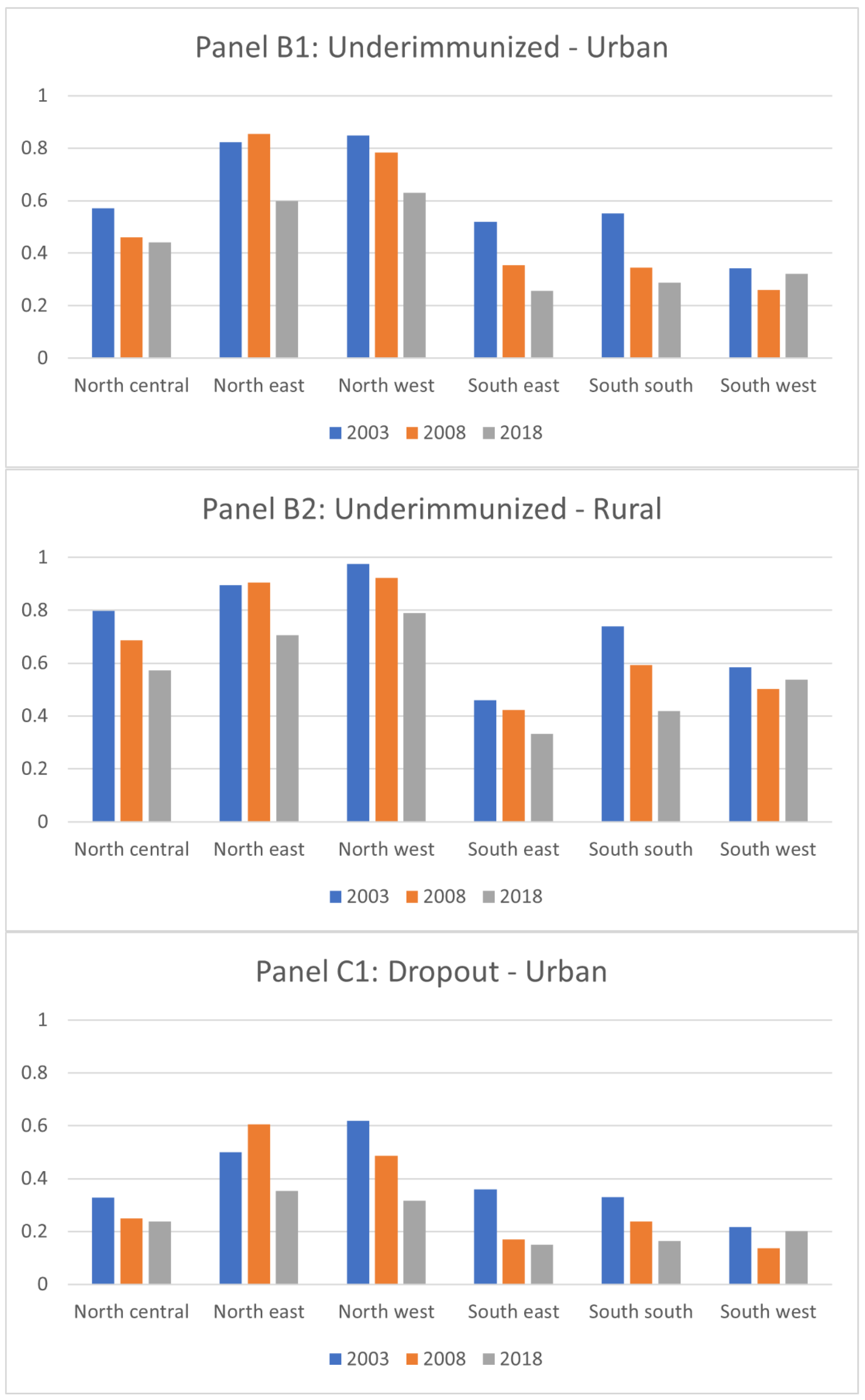
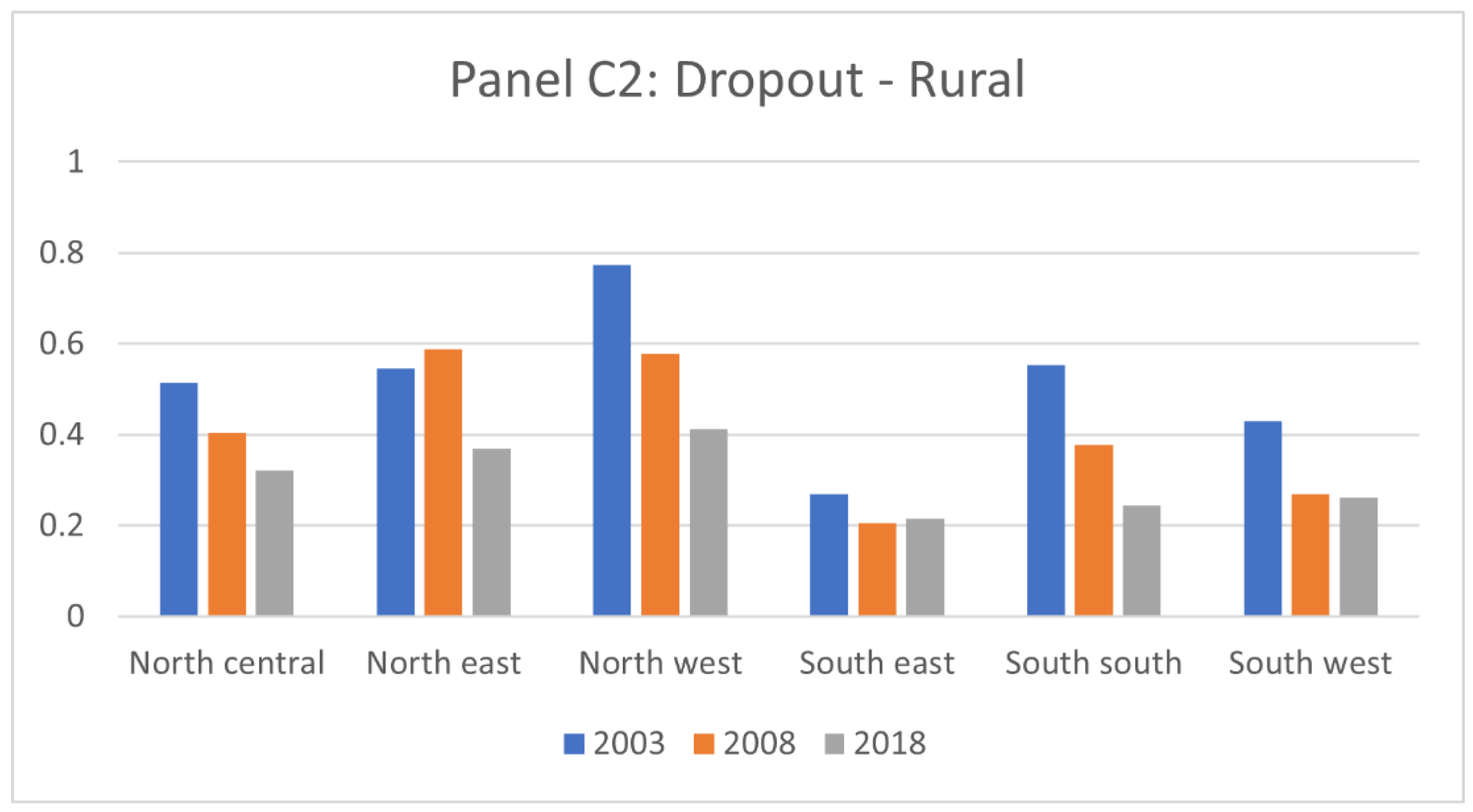
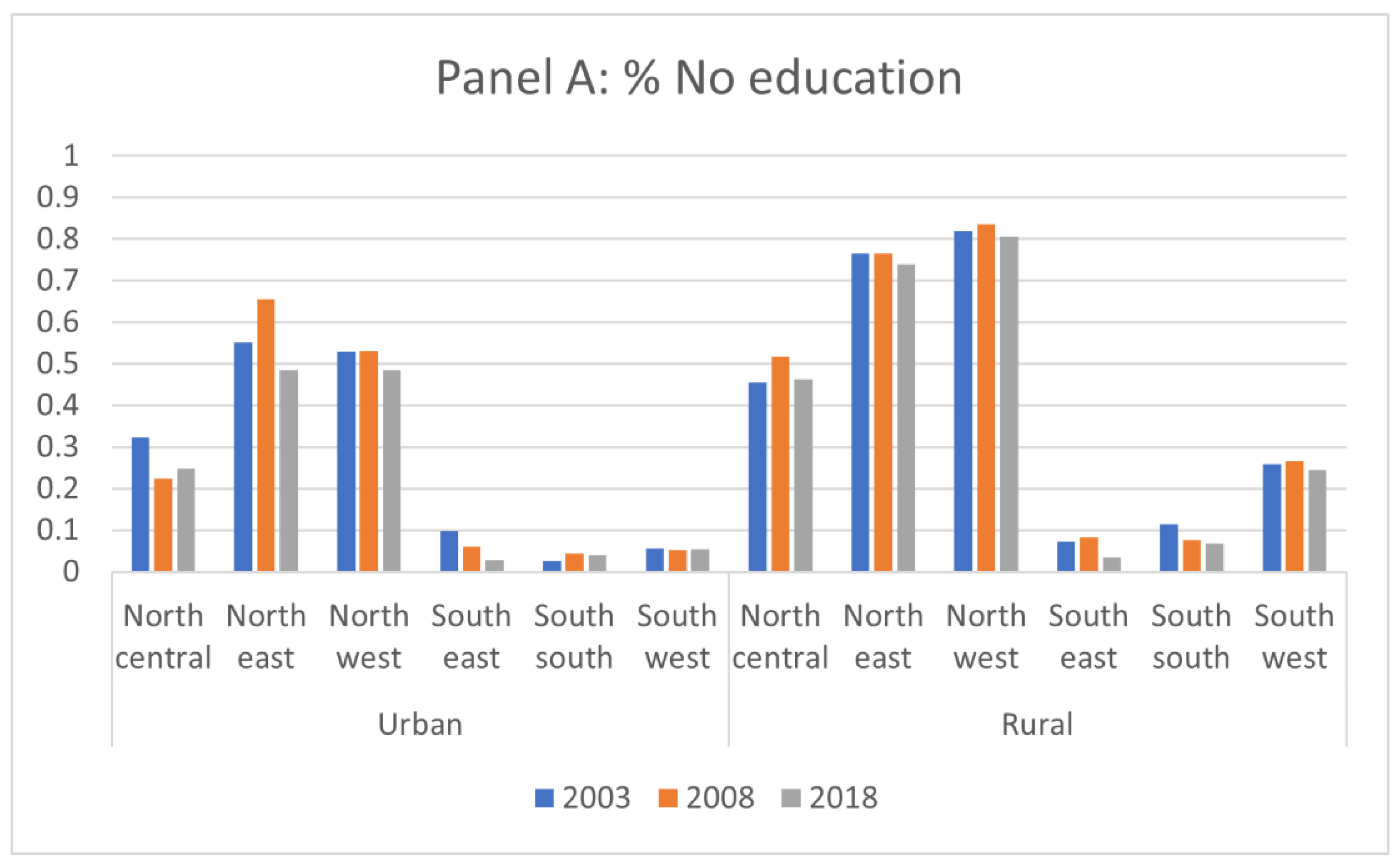

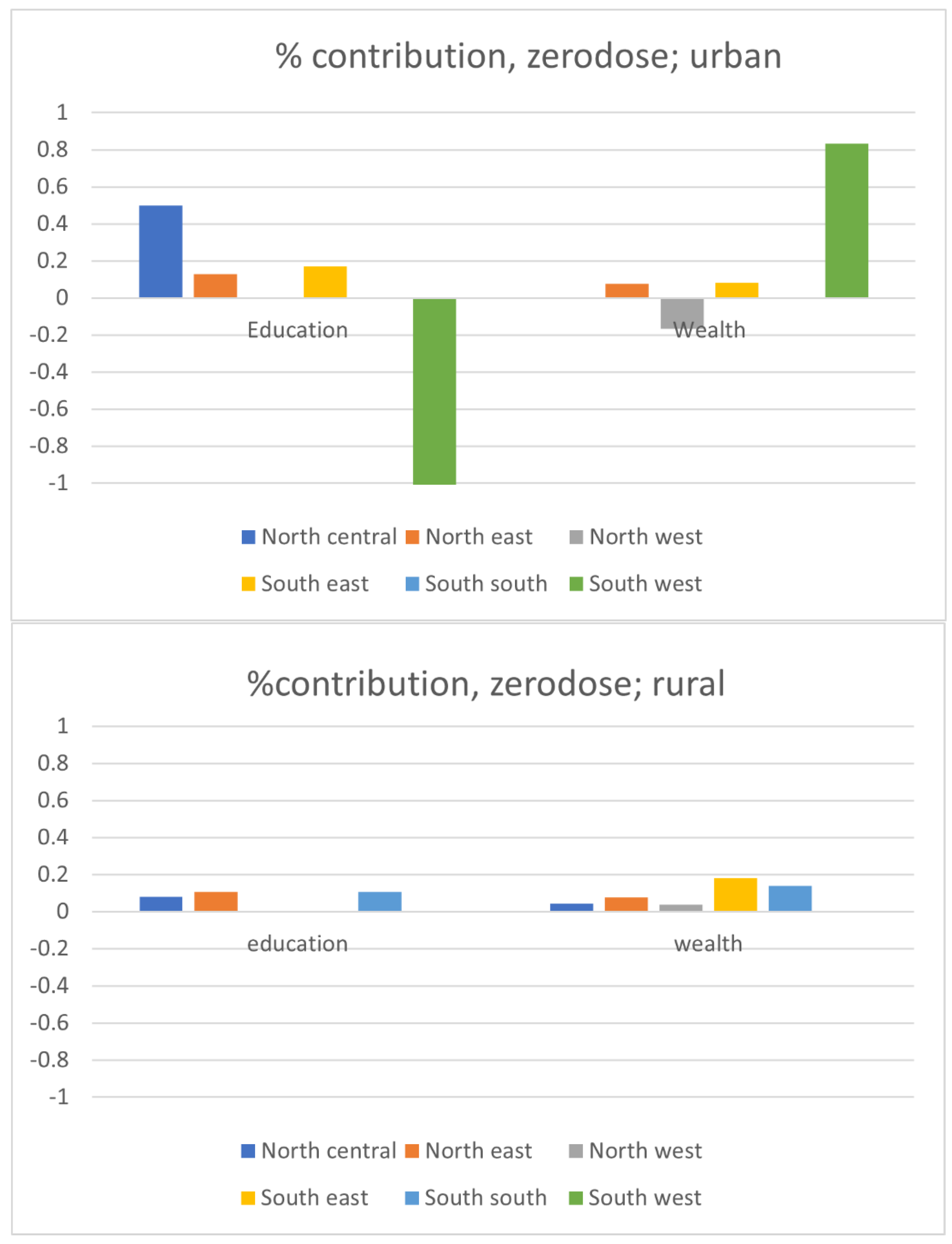
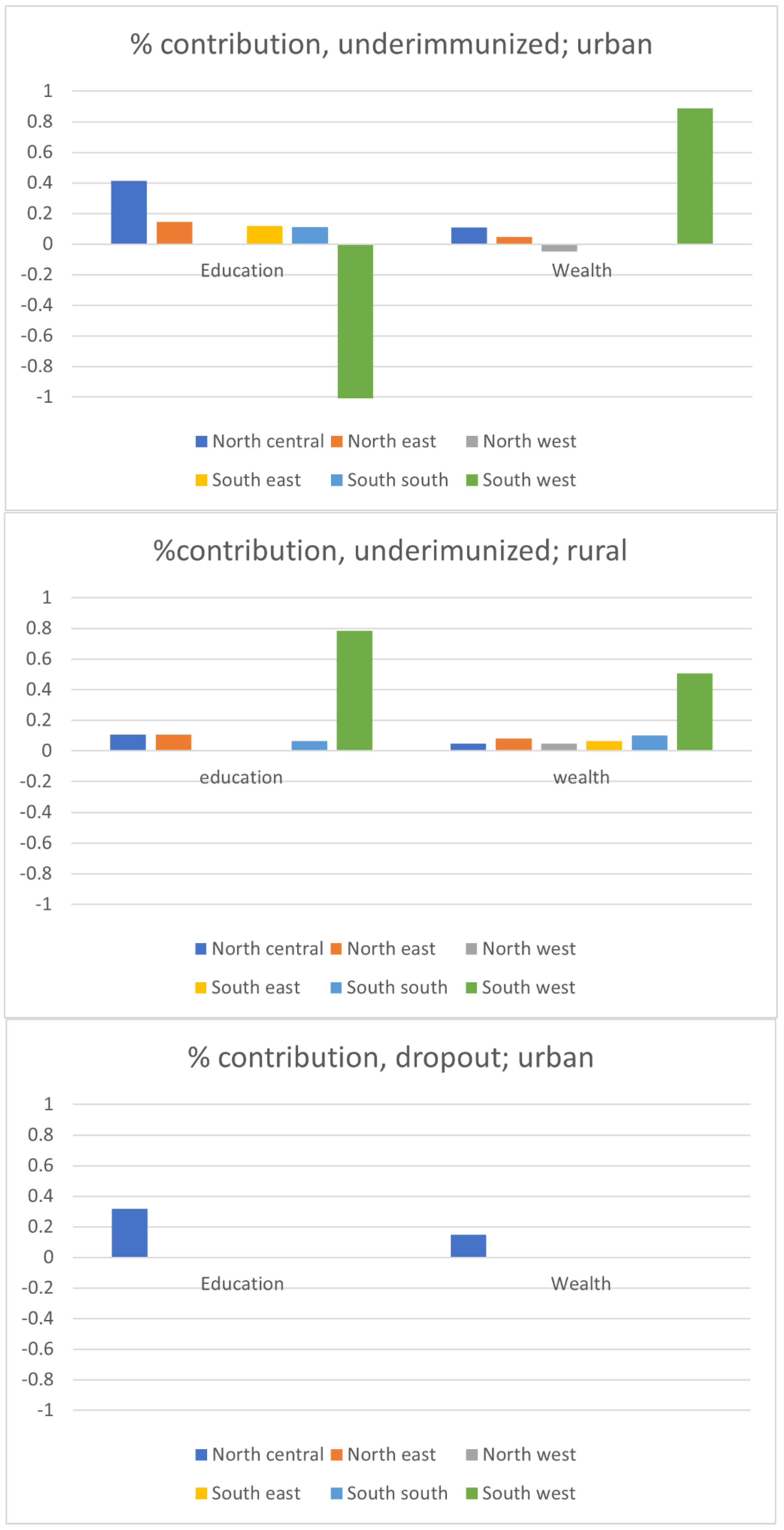
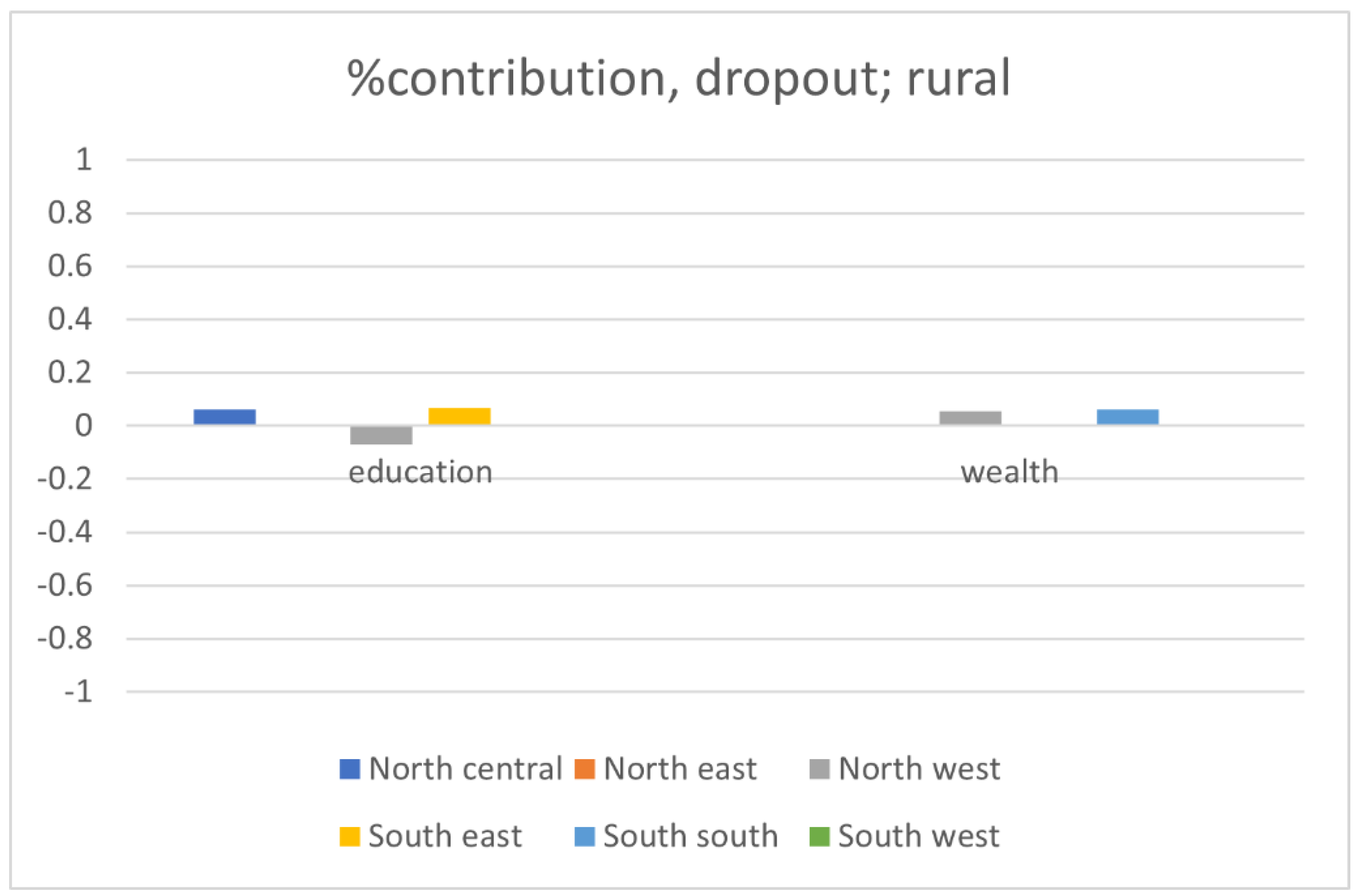
| Zero-Dose | Under-Immunized | Dropout | |||||||
|---|---|---|---|---|---|---|---|---|---|
| Total | Urban | Rural | Total | Urban | Rural | Total | Urban | Rural | |
| (1) | (2) | (3) | (4) | (5) | (6) | (7) | (8) | (9) | |
| Mother’s age | −0.005 ** | −0.004 *** | −0.005 *** | −0.004 *** | −0.005 *** | −0.004 *** | −0.004 *** | −0.003 *** | −0.004 *** |
| (0.000) | (0.001) | (0.000) | (0.000) | (0.001) | (0.000) | (0.000) | (0.001) | (0.001) | |
| Child’s age | −0.026 *** | −0.036 *** | −0.022 *** | −0.041 *** | −0.061 *** | −0.032 *** | −0.052 *** | −0.054 *** | −0.051 *** |
| (0.002) | (0.003) | (0.002) | (0.002) | (0.003) | (0.002) | (0.002) | (0.004) | (0.003) | |
| Mother’s education (comparison = no education) | |||||||||
| Primary education | −0.294 *** | −0.291 *** | −0.293 *** | −0.217 *** | −0.259 *** | −0.203 *** | −0.127 *** | −0.152 *** | −0.120 *** |
| (0.005) | (0.011) | (0.006) | (0.005) | (0.011) | (0.006) | (0.009) | (0.016) | (0.010) | |
| Secondary education | −0.444 *** | −0.426 *** | −0.457 *** | −0.381 *** | −0.418 *** | −0.367 *** | −0.209 *** | −0.228 *** | −0.203 *** |
| (0.005) | (0.009) | (0.007) | (0.005) | (0.010) | (0.006) | (0.008) | (0.014) | (0.010) | |
| Tertiary education | −0.493 *** | −0.469 *** | −0.537 *** | −0.479 *** | −0.496 *** | −0.507 *** | −0.256 *** | −0.271 *** | −0.272 *** |
| (0.009) | (0.013) | (0.016) | (0.009) | (0.014) | (0.014) | (0.012) | (0.016) | (0.019) | |
| Household wealth level (comparison = poorest) | |||||||||
| Poorer | 0.005 | −0.030 | 0.013 | −0.011 | −0.025 | −0.005 | −0.027 ** | −0.008 | −0.022 |
| (0.008) | (0.025) | (0.008) | (0.008) | (0.027) | (0.007) | (0.014) | (0.035) | (0.015) | |
| Medium | 0.032 *** | −0.002 | 0.040 *** | 0.019 *** | 0.039 | 0.021 *** | 0.015 | 0.082 ** | 0.013 |
| (0.007) | (0.024) | (0.008) | (0.007) | (0.026) | (0.007) | (0.013) | (0.035) | (0.014) | |
| Richer | −0.048 *** | −0.049 *** | −0.043 *** | −0.043 *** | −0.015 | −0.043 *** | −0.045 *** | 0.022 | −0.050 *** |
| (0.006) | (0.019) | (0.007) | (0.006) | (0.020) | (0.006) | (0.010) | (0.026) | (0.011) | |
| Richest | −0.111 *** | −0.113 *** | −0.104 *** | −0.100 *** | −0.067 *** | −0.103 *** | −0.065 *** | 0.007 | −0.074 *** |
| (0.007) | (0.018) | (0.009) | (0.007) | (0.020) | (0.008) | (0.010) | (0.025) | (0.013) | |
| Rural (comparison = urban) | 0.048 *** | 0.000 | 0.000 | 0.061 *** | 0.000 | 0.000 | 0.049 *** | 0.000 | 0.000 |
| (0.005) | (.) | (.) | (0.005) | (.) | (.) | (0.007) | (.) | (.) | |
| Survey year (comparison = 2003) | |||||||||
| 2008 | −0.073 *** | −0.074 *** | −0.073 *** | −0.092 *** | −0.120 *** | −0.080 *** | −0.128 *** | −0.120 *** | −0.135 *** |
| (0.007) | (0.012) | (0.008) | (0.006) | (0.013) | (0.007) | (0.011) | (0.016) | (0.015) | |
| 2018 | −0.174 *** | −0.139 *** | −0.192 *** | −0.195 *** | −0.203 *** | −0.193 *** | −0.227 *** | −0.185 *** | −0.258 *** |
| (0.007) | (0.012) | (0.008) | (0.007) | (0.013) | (0.008) | (0.011) | (0.016) | (0.015) | |
| _cons | 0.993 *** | 0.972 *** | 1.048 *** | 1.145 *** | 1.202 *** | 1.177 *** | 0.835 *** | 0.743 *** | 0.917 *** |
| (0.012) | (0.027) | (0.013) | (0.012) | (0.029) | (0.012) | (0.021) | (0.037) | (0.025) | |
| N | 47,439 | 14,390 | 33,049 | 47,439 | 14,390 | 33,049 | 23,925 | 9620 | 14,305 |
| r2 | 0.259 | 0.201 | 0.218 | 0.240 | 0.191 | 0.194 | 0.090 | 0.071 | 0.076 |
| Zero-Dose | Under-Immunized | Dropout | |||||||
|---|---|---|---|---|---|---|---|---|---|
| Total | Urban | Rural | Total | Urban | Rural | Total | Urban | Rural | |
| (1) | (2) | (3) | (4) | (5) | (6) | (7) | (8) | (9) | |
| Differential | |||||||||
| Prediction_1 (year = 2003) | 0.592 *** | 0.438 *** | 0.681 *** | 0.779 *** | 0.654 *** | 0.851 *** | 0.457 *** | 0.385 *** | 0.532 *** |
| (0.007) | (0.011) | (0.008) | (0.006) | (0.011) | (0.006) | (0.011) | (0.015) | (0.016) | |
| Prediction_2 (year = 2018) | 0.413 *** | 0.277 *** | 0.479 *** | 0.585 *** | 0.444 *** | 0.654 *** | 0.293 *** | 0.231 *** | 0.335 *** |
| (0.004) | (0.006) | (0.005) | (0.004) | (0.007) | (0.004) | (0.005) | (0.007) | (0.006) | |
| Difference | 0.179 *** | 0.161 *** | 0.202 *** | 0.193 *** | 0.210 *** | 0.197 *** | 0.164 *** | 0.154 *** | 0.197 *** |
| (0.008) | (0.013) | (0.009) | (0.007) | (0.013) | (0.008) | (0.012) | (0.016) | (0.017) | |
| Explained | |||||||||
| Education | 0.024 *** | 0.051 *** | 0.016 *** | 0.025 *** | 0.054 *** | 0.016 *** | −0.000 | 0.016 *** | −0.005 |
| (0.003) | (0.005) | (0.004) | (0.003) | (0.005) | (0.003) | (0.002) | (0.003) | (0.003) | |
| Wealth | 0.005 *** | 0.002 | 0.009 *** | 0.004 *** | 0.001 | 0.010 *** | 0.000 | 0.000 | 0.006 ** |
| (0.001) | (0.002) | (0.002) | (0.001) | (0.001) | (0.002) | (0.001) | (0.001) | (0.002) | |
| Rural | −0.002 *** | 0.000 | 0.000 | −0.003 *** | 0.000 | 0.000 | −0.006 *** | 0.000 | 0.000 |
| (0.000) | (.) | (.) | (0.001) | (.) | (.) | (0.001) | (.) | (.) | |
| Total | 0.027 *** | 0.053 *** | 0.025 *** | 0.027 *** | 0.055 *** | 0.026 *** | −0.006 * | 0.016 *** | 0.001 |
| (0.004) | (0.005) | (0.004) | (0.003) | (0.005) | (0.004) | (0.003) | (0.004) | (0.004) | |
| Unexplained | |||||||||
| Education | 0.000 | −0.002 | 0.001 | −0.026 *** | −0.008 | −0.058 *** | −0.002 | −0.006 | −0.017 |
| (0.007) | (0.007) | (0.015) | (0.008) | (0.008) | (0.016) | (0.008) | (0.009) | (0.017) | |
| Wealth | −0.011 *** | −0.038 ** | −0.005 | −0.005 * | −0.030 ** | −0.002 | −0.012 | −0.025 | −0.006 |
| (0.003) | (0.016) | (0.003) | (0.003) | (0.014) | (0.003) | (0.010) | (0.028) | (0.008) | |
| Rural | 0.026 ** | 0.000 | 0.000 | 0.017 | 0.000 | 0.000 | 0.026 * | 0.000 | 0.000 |
| (0.011) | (.) | (.) | (0.010) | (.) | (.) | (0.014) | (.) | (.) | |
| _cons | 0.136 *** | 0.148 *** | 0.180 *** | 0.181 *** | 0.192 *** | 0.231 *** | 0.158 *** | 0.169 *** | 0.219 *** |
| (0.016) | (0.021) | (0.018) | (0.016) | (0.021) | (0.018) | (0.024) | (0.033) | (0.025) | |
| Total | 0.151 *** | 0.108 *** | 0.176 *** | 0.167 *** | 0.155 *** | 0.171 *** | 0.170 *** | 0.137 *** | 0.196 *** |
| (0.007) | (0.012) | (0.009) | (0.007) | (0.013) | (0.007) | (0.012) | (0.016) | (0.017) | |
| N | 22,399 | 7513 | 14,886 | 22,399 | 7513 | 14,886 | 12,229 | 5129 | 7100 |
Disclaimer/Publisher’s Note: The statements, opinions and data contained in all publications are solely those of the individual author(s) and contributor(s) and not of MDPI and/or the editor(s). MDPI and/or the editor(s) disclaim responsibility for any injury to people or property resulting from any ideas, methods, instructions or products referred to in the content. |
© 2023 by the author. Licensee MDPI, Basel, Switzerland. This article is an open access article distributed under the terms and conditions of the Creative Commons Attribution (CC BY) license (https://creativecommons.org/licenses/by/4.0/).
Share and Cite
Sato, R. Zero-Dose, Under-Immunized, and Dropout Children in Nigeria: The Trend and Its Contributing Factors over Time. Vaccines 2023, 11, 181. https://doi.org/10.3390/vaccines11010181
Sato R. Zero-Dose, Under-Immunized, and Dropout Children in Nigeria: The Trend and Its Contributing Factors over Time. Vaccines. 2023; 11(1):181. https://doi.org/10.3390/vaccines11010181
Chicago/Turabian StyleSato, Ryoko. 2023. "Zero-Dose, Under-Immunized, and Dropout Children in Nigeria: The Trend and Its Contributing Factors over Time" Vaccines 11, no. 1: 181. https://doi.org/10.3390/vaccines11010181
APA StyleSato, R. (2023). Zero-Dose, Under-Immunized, and Dropout Children in Nigeria: The Trend and Its Contributing Factors over Time. Vaccines, 11(1), 181. https://doi.org/10.3390/vaccines11010181






